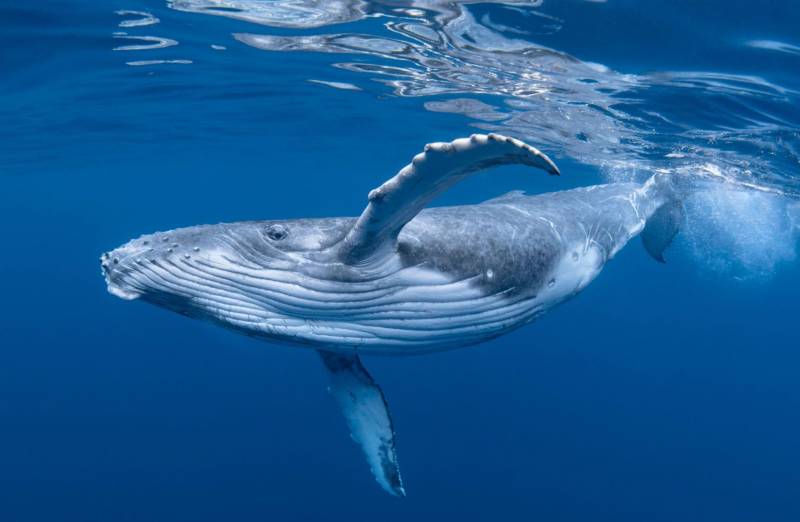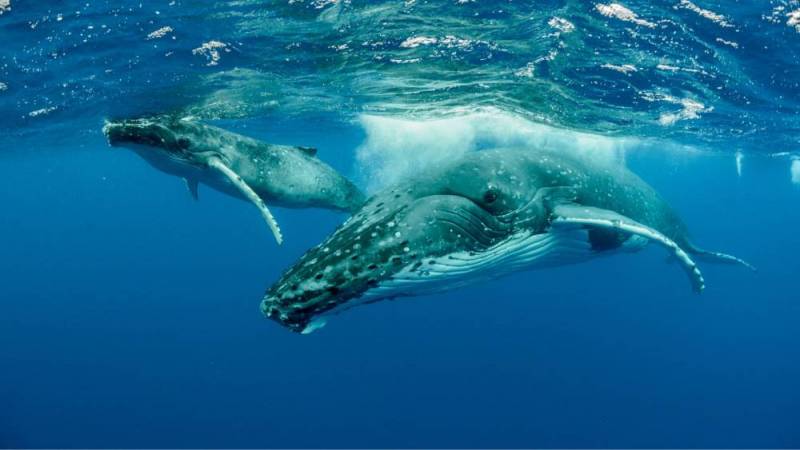Humpback whale season in Hawaii is finally here! Officially starting in November and ending in May, the peak of whale activity shines mid-January-March.
During whale season, romance is in the air, mothers are nursing and teaching their newborn calves, and lots of entertaining behavior is happening, such as breaching, blowing, pec and tail slapping, spy hopping, and dramatic fluke diving! Be sure to catch this incredible sight by booking a whale watching excursion or simply looking out from your lanai!

Let’s kick off whale season by learning 10 exciting facts!
1. Humpback whales come to Hawaii from Alaska. The Maui Nui Basin is the primary spot for humpback whale breeding and for mothers to give birth and raise their young. The Maui Nui Basin refers to the shallow waters between Maui, Kaho’olawe, Lana’i, and Moloka’i. This is a popular winter destination due to the protected and warm waters!
2. It takes humpback whales around 5 to 6 weeks to travel to Hawaii. The fastest trip recorded was 39 days! Wow, now aren’t you thankful for airplanes!
3. Humpback whales are NO LONGER ENDANGERED! Hawaii’s whaling industry started in 1819 and flourished due to the popular demand for whale oil and the Hawaiian islands being a central location between Japan and America. The whaling industry was a cornerstone of Hawaii’s economy for 40 years. In 1846 there was a record of 736 whaling ships in Hawaii. Whaling finally declined after the discovery of petroleum oil that replaced the use of whale oil. The global population of humpback whales was depleted by the 20th century. In 1973, the US government made hunting, harming, or disturbing humpback whales illegal.
4. A mineral called magnetite is found in a humpback whale’s brain; this allows the intelligent creature to navigate long distances using Earth’s magnetic field.
5. Humpback whales do not feed in Hawaii; instead, they feed in the summer months. They can survive the winter months of migration without eating due to the storage of energy in their thick layer of nutrient-dense blubber. A humpback whale can hold up to 5,000 gallons of water in their mouth. Instead of teeth, humpback whales have bristle-like filters called baleen plates that separate the krill shrimp from the water.
6. Humpback whales typically have a life span of 40-80 years; the oldest humpback whale reached 96 years old! You can tell age by size, but their earwax rings are the most accurate way to determine age. Humpback whales get a ring of ear wax in each climate (breeding versus feeding.) To calculate age, the wax plugs are sliced and counted, then divided by 2.
7. Humpback whales hold their breath for about 15 minutes at a time; therefore, they take frequent 15-minute cat naps under the water. When they rise to the surface for a breath, they exhale 90% of their air supply (humans only exhale 20%.) Humpback whales have two blow holes, one for each lung. Their lungs are about the size of a sedan car! When a whale blows or exhales, its spout is powerful and can reach up to 15 feet high!
8. A humpback whale’s pregnancy cycle lasts for about a year. These mammals give live birth to a newborn calf measuring 12-15ft long and weighing 1-2 tons! When nursing, the baby will consume up to 100 gallons of very thick and rich milk daily! The mother uses Hawaii’s warm water to prepare and strengthen her baby for the long migration back to Alaska. The baby will use the Hawaiian vacation to learn, play, and grow under its mother’s care.
9. Stick your head under the water; you may hear a surprise! Humpback whales are known for their loud and complex songs, lasting anywhere from 5 to 30 minutes. Both male and female whales can vocalize, but only males produce the intricate melodies. Scientists lack a clear understanding of the songs; however, singing has been observed during behavior relating to mating, feeding, when they have lost a loved one, or feeling lonely.
10. Humpback whales are BLONDE! This may sound silly, but humpback whales have fist-size bumps on their head and the trailing edge of their pectoral fins called Tubercles; each bump contains one stiff blonde hair.

I hope you enjoyed some interesting facts about these magnificent animals! Share what you learned with your friends and family!
Happy whale season!

Scott
March 19, 2025
So good to hear that the whales are no longer endangered.